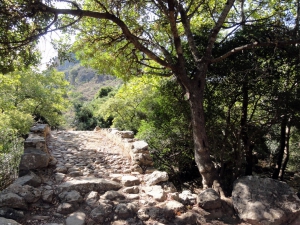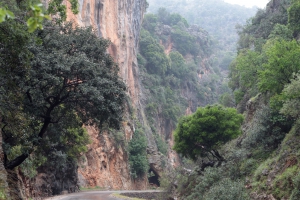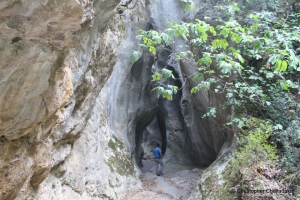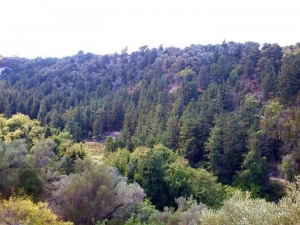Gorge Klados is one of the most dangerous and inaccessible gorges of Crete. The top (starting point) of the canyon is located at position Kokkinovari in a steep slope, 90-100 meters high. The very loose and steep terrain makes access impossible even with technical equipment.
The gorge of Eligia is wild, long and impressive. The trail to reach the gorge's bed starts in Agios Ioannis village in Sfakia (780m altitude, 92km from Chania). After hiking for 3.5 hours in the gorge ou reach Agios Pavlos beach, which is full of pine trees, and then you need 1 more hour to the west to reach Agia Roumeli.
The deepest gorge in Chania is the gorge of Aradena. The 138-meter-deep gorge is ideal not only for sightseeing or hiking but for bungee jumping as well. Trekking inside the canyon till the exit on the majestic Marmara beach is an unforgettable experience for those who attempt the descent of the canyon.
Imbros Gorge is located in the province of Sfakia and is the third most visited gorge in Crete, following Samaria Gorge and Agia Irini by Sougia. The scenery is beautiful and the low difficulty makes the descent of Imbros ideal for families with children. The length of the gorge is 11 km and the course lasts 2-3 hours.
Kallikratis is a relatively small gorge in the southeast region of Lefka Ori (White Mountains) in Chania Prefecture. The gorge connects the mountainous pasture lands with the lowland villages. It is a very pleasant walk, offering great views and rare flowers, but is not very popular with tourists. The Kallikratis Gorge together with the Asfendou Gorge can be a full day’s excursion.
The gorge of Topolia is located at West Crete and it runs along the road leading to Elafonissi. The canyon actually starts near the village Strovles at an altitude of 450m, and exits near the village Topolia, at an altitude of 150m.
Sirikari is located 55km west of Chania and 17km south of Kissamos, in a lush green area with canyons and water streams. The road to Sirikari is paved and runs through the dense vegetation, indicating the beauty of the area at the very first moment. From here begins the beautiful canyon of Sirikari leading to the settlement of Polirinia, where the ancient town of Polirinia was built.
On the way to Elafonisi from the road running along the west coast of Crete, there is the beautiful village of Cambos belonging to Kissamos province. From there a short dirt road heads to the west which heads to the lush canyon of Kambos, the westernmost gorge of Crete.
Deliana – Mesavlia Gorge is located 37km west of Chania. Starting from the village Mesavlia it descends to the village Deliana after 5km. Walking in the gorge is very easy (takes about one hour) and is suggested even for children, as it runs along a dirt road.
The gorge of Rocca, Roka, Rocka or Rokka is located 32km west of Chania, in the area of Kolymbari. The 2km gorge starts from the village Deliana and ends at the village of Roka. In the settlement there is Trouli hill, where you can still see the ruins of a Byzantine fortress.
The Gorge of Therisso (named also Eleftherios Venizelos) is located near the city of Chania. You can go there by car. The main gorge is six kilometers long. The vertical cliffs are impressive and the lush vegetation has nothing to envy of the other Chania Gorges. The place deserves a visit, even with a vehicle, cobined with a visit in the historical beautiful village of Therisso.
One of the nicest gorges of Crete is that of Vrissi on the north side of the White Mountains, crossed by the river Vrissiotis which gathers water from Melidaou area and waters Zourva and Lakki. In the gorge there is the cave - underground river with water springs, while many waterfalls of exquisite beauty are met in several places. The trail to the spring of the cave starts from Lakki and ascends along the walls of the gorge. From the spring starts another downhill trail to Zourva.
The canyon of Diktamos starts 21km east of Chania, next to the village Katochori at an altitude of 300m, and ends 8km eastern, at the village Faragi, at an altitude of 40m, next to the village of Stylos. Thus, it is also known as Katechori Gorge or Stylos Gorge.
Avlaki gorge is located near the monastery Gouverneto, 16km east of Chania city. It is one of the most important gorges in Crete with a particular religious value, as many monks and hermits found shelter in its caves. Inside the small canyon there is the deserted Katholiko monastery, perhaps the oldest monastery in Crete. Thus, the gorge is also called Katholiko Gorge.
The canyon Kakoperatos is located by Agios Vasilios village at the province of Agios Vasilios. It’s a tributary of the Megalos River (Kourtaliotis) and as its name suggests (bad passage in Greek) it cannot be accessed from humans (by trekking).
The Gorge of Kourtaliotis is located 22km south of Rethymno and has a length of 3km. It is one of the most spectacular natural attractions of Rethymnon. It starts from the village of Koxare and flows between the mountains Kouroupis (984 m) and Xiro Oros (Dry Mountain - 904m). The huge cliffs of the canyon reach a height of 600 meters and are full of openings and caves, where significant fauna species live.
Fratiano Gorge is one of the long canyons of Rethymno Prefecture, running alongside Kourtaliotiko Gorge and crossing Xiro Oros Mount. Its entrance is located 23km southeast of Rethymnon, next to the village Frati, and it mouth is located near the exit of the gorge Kourtaliotiko.
Margarites is a village, well known for its marvelous architecture and the traditional pottery. However, in the wider area of the villages of Margarites, Orthe and Eleftherna appear a series of small, parallel gorges. Small streams such as Margaritianos flow towards the north and are tributaries of the Geropotamos River. The gorges are developed in white-yellow marly limestone of the Upper Miocene period (8-10 million years ago) as a result of the uplift of the whole area and the erosion by water.
The gorge of Patsos or Agios Antonios is located 8 km southwest of the Monastery of Arkadi, in the heart of the lush province of Amari. The water of the gorge is poured into the dam of Potamoi. Trekking in the gorge is very easy since it is managed by the Forest Service.


































































































